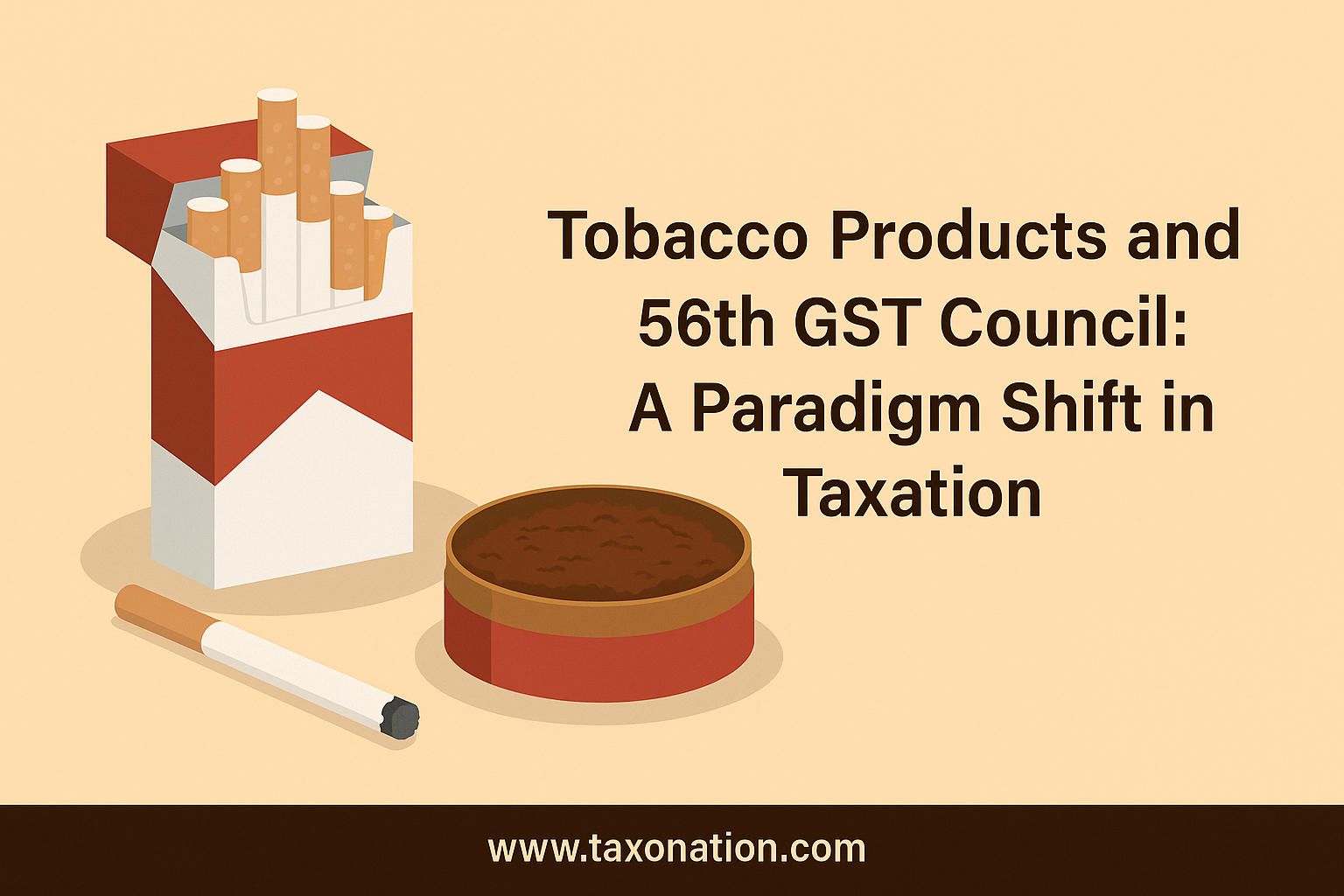
1. Introduction
The 56th GST Council meeting has brought one of the most significant policy changes in recent years, particularly concerning tobacco and allied products. Tobacco has historically been a sector under strict fiscal regulation, both due to its health implications and its potential for revenue generation. The latest Council recommendations, by shifting to a Retail Sale Price (RSP)-based taxation system and substantially revising the rates, mark a decisive step towards curbing tax evasion, ensuring uniform taxation, and addressing the twin objectives of public health and revenue protection.
This article examines the historical context, the changes announced, and their far-reaching implications for stakeholders across the tobacco supply chain.
2. Historical Background
Taxation of tobacco has always been a sensitive subject in Indian fiscal policy. Under the pre-GST era, excise duties formed the major component of tax on tobacco and were largely levied on an RSP basis. This system ensured that even if manufacturers or distributors
under-reported transaction values, tax revenue was secured on the printed retail price.
However, post the introduction of Goods and Services Tax (GST) in 2017, tobacco was brought into the 28% GST slab, coupled with an additional Compensation Cess. Despite this dual-layer taxation, evasion remained rampant. Many manufacturers declared artificially
low transaction values while continuing to charge consumers the full retail price. Consequently, the effective incidence of tax was diluted, leading to loss of government revenue and creating unfair competition for compliant businesses.
Pan Masala, Gutkha, Zarda, and cigarettes, being high-demand items with considerable margins, were the most affected by this undervaluation practice. Recognizing this leakage, the GST Council has now realigned the system by returning to the RSP-based model.
3. Rate Change Announced in the 56th GST Council Meeting
The changes introduced are both rate-based and valuation-based.
Bidis: Reduced from 28% to 18%.
Bidi Wrapper Leaves (Tendu) and Indian Katha: Reduced from 18% to 5%.
Cigarettes, Cheroots, Cigarillos, Cigars: Increased from 28% to 40%.
Other Manufactured Tobacco & Substitutes: Increased from 28% to 40%.
Unmanufactured Tobacco (other than leaves): Increased from 28% to 40%.
Pan Masala (HSN 2106 90 20): Revised from 28% to 40%.
Gutkha, Chewing Tobacco (Zarda): Shifted to RSP-based valuation.
The key structural reform is the RSP-based valuation system, where GST and Compensation Cess (where applicable) will be calculated directly on the maximum retail price, rather than the transaction value.
Another critical decision is that while these revised rates are notified, Pan Masala, Gutkha, Cigarettes, Chewing Tobacco, and Bidis will continue at existing rates until compensation cess loan and interest obligations are discharged. This balancing act protects revenue
needs while phasing in reforms.
4. Implications of the Changes
(a) For the Government
Revenue Enhancement: Tax leakage from under-invoicing will be plugged, leading to substantial growth in collections.
Transparency: RSP-based system ensures clarity and uniformity across states, reducing classification disputes.
Debt Servicing: Continuation of existing cess till loan and interest obligations are discharged secures the Centre’s fiscal responsibility.
(b) For the Industry
Compliance Burden: Manufacturers must ensure correct printing and declaration of RSP. Any manipulation will invite strict penalties.
Pricing Adjustments: Effective tax incidence on some products may rise up to 70–75% of retail price, impacting pricing strategies.
Level Playing Field: Smaller unorganized players who relied on undervaluation may face severe challenges, while compliant businesses benefit.
(c) For Consumers
Price Impact: Cigarettes, Pan Masala, Gutkha, and Chewing Tobacco are likely to witness price increases.
Public Health Advantage: Higher retail prices may reduce consumption, aligning with India’s public health policy goals.
(d) Legal & Compliance Landscape
Litigation related to valuation disputes (transaction value vs RSP) is expected to reduce.
The Council’s move ensures uniformity across states, reducing interpretational ambiguity.
5. Future Scope and Planning
The Council’s decisions open several avenues for future reforms:
Gradual Phase-Out of Compensation Cess: Once cess loan obligations are repaid, cess on tobacco products will be merged into GST. The timing of this depends on government debt clearance, but it is a matter of when, not if.
Technology-Driven Monitoring: To further prevent evasion, measures such as track-and-trace systems, QR codes on packs, and e-invoicing integration may be introduced.
Public Health Integration: Higher taxation aligns with India’s commitments under the WHO Framework Convention on Tobacco Control (FCTC). Future budgets may combine fiscal measures with awareness campaigns.
International Benchmarking: Many countries tax tobacco at rates ensuring incidence above 70% of RSP. With the current reforms, India has aligned itself with this global standard.
Impact on Allied Sectors:Agriculture: Bidi leaves (tendu) and katha have been given relief with reduced rates, protecting traditional forest-based farmers livelihoods.
Employment: The bidi sector, being labour-intensive, (small or laghu udyogs) may see partial relief, but the organized cigarette industry will face higher compliance pressure.
While industry players will face increased compliance requirements and possibly higher costs, the move ultimately establishes a transparent, efficient, and globally consistent tax structure. As the cess phase-out approaches, stakeholders must prepare for a system
where simplicity and transparency dominate.
The taxation of tobacco products thus stands at the crossroads of revenue policy, compliance discipline, and public health priorities — and the 56th Council has attempted to balance all three with remarkable precision.
By CA Ayoosh Banka
Youtube link- https://youtu.be/-HAfa1ewSxw?si=2ilqDL4gNJiVsII_
Click here to read Full Press Release of 56Th GST Council Meeting
FAQs on 56th GST Council Meet: Rate Changes, Exemptions & Key Reforms.
SUBSCRIBE GST & INCOME TAX E-LIBRARY (INDIA'S HIGHEST CASE LAW DATA)
FOR MORE UPDATE ON GST/ IT JOIN OUR FREE WHATSAPP GROUP BY CLICKING ON THIS LINK https://chat.whatsapp.com/C8VB6F6VHme3A061UDQKhj
Comment: